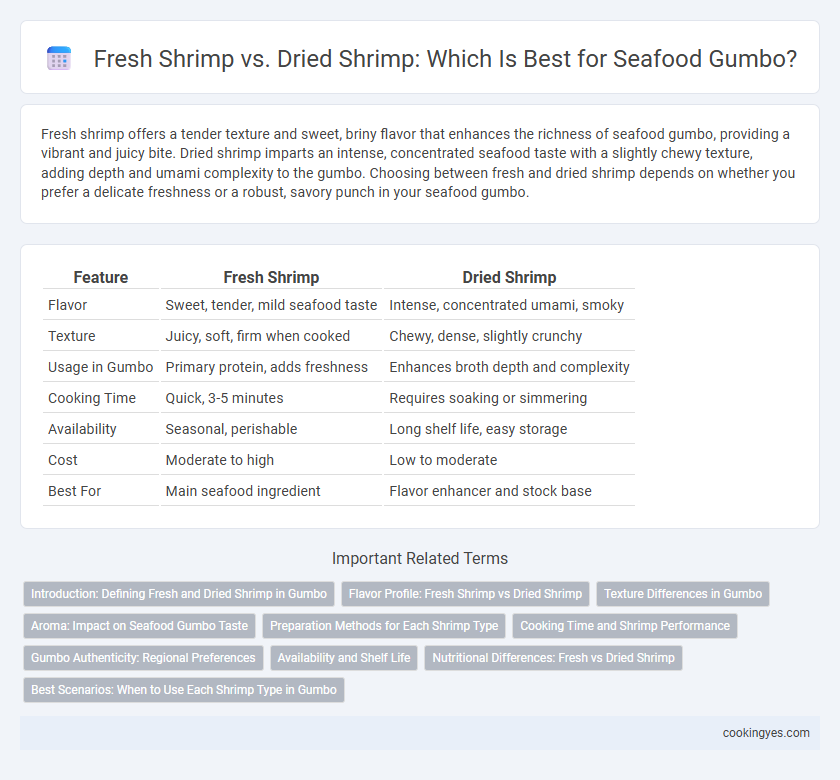Fresh shrimp offers a tender texture and sweet, briny flavor that enhances the richness of seafood gumbo, providing a vibrant and juicy bite. Dried shrimp imparts an intense, concentrated seafood taste with a slightly chewy texture, adding depth and umami complexity to the gumbo. Choosing between fresh and dried shrimp depends on whether you prefer a delicate freshness or a robust, savory punch in your seafood gumbo.
Table of Comparison
| Feature | Fresh Shrimp | Dried Shrimp |
|---|---|---|
| Flavor | Sweet, tender, mild seafood taste | Intense, concentrated umami, smoky |
| Texture | Juicy, soft, firm when cooked | Chewy, dense, slightly crunchy |
| Usage in Gumbo | Primary protein, adds freshness | Enhances broth depth and complexity |
| Cooking Time | Quick, 3-5 minutes | Requires soaking or simmering |
| Availability | Seasonal, perishable | Long shelf life, easy storage |
| Cost | Moderate to high | Low to moderate |
| Best For | Main seafood ingredient | Flavor enhancer and stock base |
Introduction: Defining Fresh and Dried Shrimp in Gumbo
Fresh shrimp, characterized by their moist texture and briny flavor, are essential for a lively seafood gumbo, providing a tender bite and natural sweetness. Dried shrimp, on the other hand, offer a concentrated umami taste and chewy consistency, intensifying the gumbo's depth with a smoky, salt-cured essence. Choosing between fresh and dried shrimp impacts the gumbo's overall flavor profile and authenticity, balancing freshness with rich, savory notes.
Flavor Profile: Fresh Shrimp vs Dried Shrimp
Fresh shrimp in seafood gumbo offers a sweet, briny flavor with a tender texture that enhances the broth's natural seafood notes. Dried shrimp contributes a concentrated, umami-rich taste with a slightly chewy consistency, intensifying the gumbo's depth and complexity. Combining both types can balance freshness and robust savoriness, creating a layered and flavorful dish.
Texture Differences in Gumbo
Fresh shrimp provide a tender, succulent texture that enhances the rich, stew-like consistency of seafood gumbo, allowing the shrimp to blend seamlessly with the broth. Dried shrimp, on the other hand, contribute a chewier, more concentrated bite that adds a unique umami depth and a firmer texture contrast within the gumbo. Choosing between fresh and dried shrimp impacts the overall mouthfeel, with fresh shrimp creating a softer, silkier experience and dried shrimp offering a distinct, textured variation.
Aroma: Impact on Seafood Gumbo Taste
Fresh shrimp imparts a delicate, briny aroma that enhances the overall freshness of seafood gumbo, creating a vibrant and light flavor profile. Dried shrimp contributes a concentrated, umami-rich scent that deepens the gumbo's complexity with a smoky, savory undertone. The aroma differences significantly influence the gumbo's taste, with fresh shrimp providing brightness while dried shrimp adds a robust, intense seafood essence.
Preparation Methods for Each Shrimp Type
Fresh shrimp for seafood gumbo require thorough cleaning and deveining before cooking, ensuring a tender texture and natural sweetness. Dried shrimp need to be soaked in warm water for 15-30 minutes to rehydrate, releasing intense umami flavors that deepen the gumbo's complexity. Both preparation methods significantly influence the gumbo's final taste and texture, with fresh shrimp offering a delicate bite and dried shrimp providing a concentrated seafood essence.
Cooking Time and Shrimp Performance
Fresh shrimp cooks quickly in seafood gumbo, typically within 3 to 5 minutes, providing a tender texture and a clean, sweet flavor that complements the broth without overpowering it. Dried shrimp require longer soaking or simmering times to rehydrate, which enhances the gumbo's depth with a concentrated umami and briny taste but can result in a chewier texture. Selecting fresh shrimp boosts the dish's freshness and quick preparation, while dried shrimp enrich the gumbo's complexity through extended cooking and intensified shrimp performance.
Gumbo Authenticity: Regional Preferences
Fresh shrimp delivers a moist, tender texture that complements Cajun and Creole gumbos typical in Louisiana, enhancing authenticity in coastal recipes. Dried shrimp, favored in certain Southern Creole and Gullah regions, imparts a concentrated, umami-rich flavor, deepening the gumbo's complexity and reflecting regional culinary traditions. Choosing between fresh and dried shrimp aligns with local preferences, preserving the gumbo's cultural and geographic identity.
Availability and Shelf Life
Fresh shrimp offers superior flavor and texture for seafood gumbo but requires immediate use or refrigeration, limiting its availability and shelf life to a few days. Dried shrimp provides a convenient alternative with a significantly longer shelf life, often lasting months when stored properly, and is readily available in many grocery and specialty stores. Choosing between fresh and dried shrimp depends on the desired freshness and convenience for gumbo preparation.
Nutritional Differences: Fresh vs Dried Shrimp
Fresh shrimp offers higher moisture content and a boost in vitamins like B12 and D, supporting hydration and immune function in seafood gumbo. Dried shrimp, rich in concentrated protein and minerals such as calcium and iron, enhances the gumbo's nutritional density and umami flavor profile. Choosing between fresh and dried shrimp impacts not only taste but also the nutritional balance of the seafood gumbo.
Best Scenarios: When to Use Each Shrimp Type in Gumbo
Fresh shrimp provides a tender texture and sweet flavor, making it ideal for seafood gumbo where a delicate, briny taste is desired, especially in lighter broths. Dried shrimp delivers a concentrated umami depth and smoky richness, perfect for robust, spicy gumbos or as a flavor enhancer in darker roux-based recipes. Use fresh shrimp when aiming for freshness and subtlety, while dried shrimp excels in intensifying savory complexity and adding a traditional Southern twist.
Fresh shrimp vs dried shrimp for seafood gumbo Infographic

 cookingyes.com
cookingyes.com